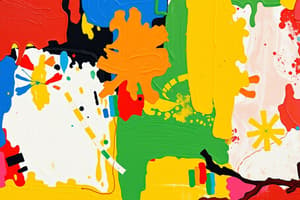Podcast
Questions and Answers
What is the term for adding white to a color?
What is the term for adding white to a color?
- Hue
- Tint (correct)
- Shade
- Tone
Cool hues are based on yellow.
Cool hues are based on yellow.
False (B)
What are the three primary colors?
What are the three primary colors?
Red, Blue, and Yellow
A color that is opposite another on the color wheel is called a ______ color.
A color that is opposite another on the color wheel is called a ______ color.
Match the skin complexion descriptor with its corresponding color description:
Match the skin complexion descriptor with its corresponding color description:
Which of these facial profile types has a forehead and chin that recede, making the middle of the face more prominent?
Which of these facial profile types has a forehead and chin that recede, making the middle of the face more prominent?
The ideal width of an oval face is equal to 5 eye lengths.
The ideal width of an oval face is equal to 5 eye lengths.
What is the purpose of applying blush?
What is the purpose of applying blush?
When applying blush to a long or narrow face, it should be applied ______ to add width.
When applying blush to a long or narrow face, it should be applied ______ to add width.
Match the eye correction technique with its corresponding eye feature:
Match the eye correction technique with its corresponding eye feature:
Which of the following brow features is usually associated with a round brow start?
Which of the following brow features is usually associated with a round brow start?
The arch of the eyebrow should be positioned above the iris.
The arch of the eyebrow should be positioned above the iris.
How can you distinguish between a concave and a convex facial profile?
How can you distinguish between a concave and a convex facial profile?
Which of the following is NOT a primary objective of foundation?
Which of the following is NOT a primary objective of foundation?
Skin tone correctors should always be mixed with foundation for Asian or dark skin tones.
Skin tone correctors should always be mixed with foundation for Asian or dark skin tones.
What is the purpose of green skin tone corrector?
What is the purpose of green skin tone corrector?
Concealers are typically applied in a ______ motion to blend seamlessly.
Concealers are typically applied in a ______ motion to blend seamlessly.
Match the skin tone corrector color with its primary use:
Match the skin tone corrector color with its primary use:
What is the primary difference between contouring and highlighting?
What is the primary difference between contouring and highlighting?
The temporal bone is the only moveable facial bone.
The temporal bone is the only moveable facial bone.
Which facial bone is key for contouring to enhance cheekbones?
Which facial bone is key for contouring to enhance cheekbones?
Flashcards
Three Zones of the Face
Three Zones of the Face
Frontal, Middle, and Lower zones categorize facial features: hairline to eyebrows, eyebrows to nose, nose to chin.
Frontal Zone
Frontal Zone
The upper part of the face extending from the hairline to the eyebrows.
Middle Zone
Middle Zone
The area from the eyebrows to the base of the nose, often sensitive to expressions.
Lower Zone
Lower Zone
Signup and view all the flashcards
Oval Face Proportions
Oval Face Proportions
Signup and view all the flashcards
Blush Application Guidelines
Blush Application Guidelines
Signup and view all the flashcards
Close-Set Eyes Correction
Close-Set Eyes Correction
Signup and view all the flashcards
Key Brow Points
Key Brow Points
Signup and view all the flashcards
Hue
Hue
Signup and view all the flashcards
Complementary Colors
Complementary Colors
Signup and view all the flashcards
Undertone
Undertone
Signup and view all the flashcards
Primary Colors
Primary Colors
Signup and view all the flashcards
Cool Hues
Cool Hues
Signup and view all the flashcards
Order of Application
Order of Application
Signup and view all the flashcards
Foundation Objectives
Foundation Objectives
Signup and view all the flashcards
Green Skin Tone Corrector
Green Skin Tone Corrector
Signup and view all the flashcards
Concealer Usage
Concealer Usage
Signup and view all the flashcards
Highlighting
Highlighting
Signup and view all the flashcards
Contouring
Contouring
Signup and view all the flashcards
Mandible
Mandible
Signup and view all the flashcards
Key Facial Bones
Key Facial Bones
Signup and view all the flashcards
Study Notes
Color Theory
- Hue: Pure color, differentiating one from another (e.g., red vs. blue)
- Intensity: Vividness or brightness of a color
- Value: Lightness or darkness of a color
- Tint: Adding white to a color (highest value)
- Shade: Adding black to a color (lowest value)
- Tone: Adding gray to a color (middle value)
- Primary Colors: Red, blue, yellow
- Secondary Colors: Orange, green, violet
- Complementary Colors: Colors opposite each other on the color wheel (e.g., red and green)
- Cool Hues: Blue-based colors like blue, violet, and green
- Warm Hues: Yellow-based colors like red, orange, and peach
- Skin Complexion Descriptors:
- Ruddy: Red or flushed appearance
- Sallow: Yellowish or pale appearance
- Best/Worst Colors for Skin Tones:
- Warm Undertones (Peach/Golden): Peaches, corals, golden browns, rusts work well.
- Cool Undertones (Bluish-Pink, Olive): Blues, violets, cherry reds, and fuchsias are flattering.
- Neutral Colors: Suited for almost anyone, as they aren't strongly blue or yellow-based.
Preparing the Canvas
- Undertone vs. Overtone:
- Undertone: Subtle hue under the surface (e.g., warm, cool, neutral) that doesn't change.
- Overtone: Surface skin color that may change with seasons or conditions (e.g., redness, tanning).
- Swatching/Testing Foundation:
- Best areas for testing: Neck or jawline.
- Avoid testing on wrists, hands, or forehead.
- Order of Application:
- Primer/Moisturizer
- Skin Tone Correctors (optional)
- Foundation
- Concealer (before or after foundation)
- Powder
- Objectives of Foundation:
- Protect the skin (often contains sunscreen)
- Even out skin tone
- Hide imperfections
- Create a base for makeup
Skin Tone Correctors
- Green: Cancels redness (e.g., acne or rosacea)
- Pink: Brightens dull complexions
- Lavender: Neutralizes sallowness
- Yellow/Orange: Corrects blue or greenish under-eye darkness
- Application Tips:
- For Asian or dark skin tones, always mix with foundation.
- Can be used before foundation or mixed with it for Caucasian skin.
Concealers
- Has higher pigment concentration than foundation
- Available in various types (pot, stick, tube)
- Uses:
- Hide dark circles, scars, pigmentation, and skin conditions
- Application Tips
- Apply in a stippling motion (pat to blend).
- Yellow undertones are best for under-eye darkness.
- Use "Hollywood V Technique" for shaping the face.
Contouring & Highlighting
- Main Objectives: Highlighting (Matte or iridescent) brings features forward, and Contouring (Matte Only) pushes areas back to create depth. Sculpting is the combination of both. Common Uses: Correcting facial proportions (e.g., short forehead, receding chin, long nose). Enhancing natural bone structure (cheekbones, jawline, nose, etc.).
Bones of the Face & Corrective Techniques
- Facial bone structure:
- Face is made up of 14 bones
- 13 bones are connected.
- The mandible (lower jaw) is the only moveable facial bone.
- Zygomatic (Cheekbones): Key for contouring, found by pressing on cheek area. Enhances contouring; high cheekbones can be accentuated with highlight/shading.
- Mandible (Jawbone): Helps define jawline contour. Defines lower face; contouring can soften or sharpen jawline appearance.
- Orbital (Eye Sockets): Determines eye makeup corrections. Affects how shadows and highlights are placed around the eyes.
- Temporal (Temples): Can be contoured for a slimmer face effect. Understanding the depth assists in aging makeup or creating hollow-cheek effects.
Facial Proportions & Zones
- Three Zones of the Face:
- Frontal Zone (Superior/Frontal) – Hairline to eyebrows
- Middle Zone (Median/Sensitive) – Eyebrows to nose base
- Lower Zone (Inferior/Instinctive) – Nose base to chin
- Facial Profile Types:
- Straight: Ideal, forehead & chin aligned
- Convex: Forehead & chin recede, middle of face more prominent
- Concave: Forehead & chin are prominent, middle of face set back
- Oval Face Proportions
- Ideal Face Shape
- Width = 5 eye lengths
- Mouth Width = Distance between irises.
- Minimal contouring/highlighting needed.
Blush Application
- Purpose of blush: Designed to give complexion a healthy glow and serve other purposes
- General Guidelines:
- Apply starting from outer cheek toward the center.
- Use imaginary lines from pupil & base of the nose to determine placement.
- Different application for different face shapes:
- Long or Narrow Face: Apply horizontally at the cheekbone to add width.
- Short or Round Face: Apply in diagonal/triangular shape to lengthen.
- Square Face: Circular application to soften edges.
- Heart Face: Square blush placement below cheekbones.
- Pear Face: Blush low on cheeks, blend up and out toward hairline
- Lighting & Makeup
- Different light sources affect makeup perception.
- Adjust color choices accordingly.
Eye Makeup & Corrections
- 5 Points of Eye Analysis
- Size: Small, average, large, prominent
- Shape: Upturned, average, downturned
- Spacing: Close-set, wide-set, or balanced
- Balance: Visibility of lid, crease, and brow bone
- Corrective Eye Makeup Techniques:
- Close-Set Eyes: Light shades inside, dark outside, extend liner outward
- Wide-Set Eyes: Dark shades inside, light outside, bring brows closer.
- Deep-Set Eyes: Light on lids, dark in crease, avoid upper liner.
- Protruding Eyes: Matte, dark shades, minimal shimmer
- Hooded Eyes: Dark on hood, highlight brow bone.
Eyebrows & Corrections
- 3 Key Brow Points
- Start: Inner corner of eye
- Arch: Above iris
- End: Diagonal from nostril to outer eye corner
- Corrections:
- Round Brow Start: Makes forehead wider, eyes appear farther apart.
- Square Brow Start: Slenderizes nose, brings eyes closer.
- Long Nose: Brows farther apart, arch further out
- Short Nose: Angular brows to create length
- Wide Nose: Brows closer together with square start
- Narrow Nose: Brows farther apart with round square start
Key Qualities of a Successful Makeup Artist
- Artistic Skill: Ability to enhance features
- Client Engagement: Knowledge of trends & product recommendations
- Observation Skills: Assessing client's best features, skin type, tone, face shape, and problem areas.
Studying That Suits You
Use AI to generate personalized quizzes and flashcards to suit your learning preferences.





